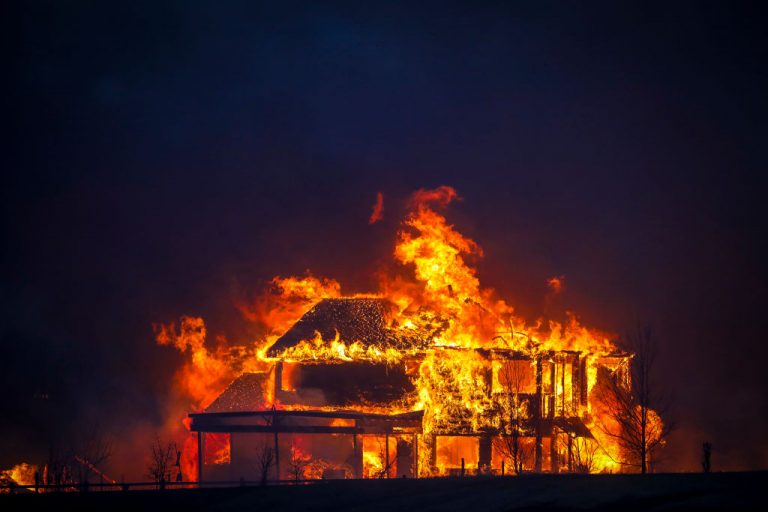Search teams are still trying to locate two people amongst smoldering debris from a massive wildfire that has destroyed nearly 1,000 homes and buildings in Colorado.
The inferno, which broke out on Dec. 30, torched through over 9.4 square miles across suburbs of Denver and Boulder. A total of 991 buildings were reported to be completely destroyed while thousands of residents sifted through the charred remains of their homes in hopes of any valuables that may have survived.
Although the blaze mostly destroyed residential homes, it also burned through eight businesses at a shopping center in Louisville, including a nail salon and a Subway restaurant. In the neighboring town of Superior, 12 businesses were damaged, including a Target, Chuck E. Cheese, Tesla dealership, a hotel and the town hall.
The two towns are located about 20 miles northwest of Denver and are home to a combined population of 34,000. At this time, the two people still missing are presumed dead.
Experts say the fire occurred unusually late in the year following an extremely dry fall and hardly any snowfall. They believe those conditions, coupled with high winds and low levels of moisture, helped the fire spread and retain its intensity.
Success
You are now signed up for our newsletter
Success
Check your email to complete sign up
The disaster is the latest event triggered by extreme weather as climate change and a La Niña weather pattern have left much of the American West in severe drought. “This was a horrific convergence of two things,” Colorado Governor Jared Polis said. “We had an unusually dry and warm winter and historic wind gusts.”
Colorado’s drought-parched grasslands at the base of the Rocky Mountains are notorious for its flammable grasses that act like kindling in dry weather. Campfires have been strictly banned all year round in hopes of preventing wildfires from igniting.
Boulder Sheriff: Cause of fire still being investigated
Boulder County Sheriff Joe Pelle said authorities are pursuing a number of tips and had executed a search warrant at “one particular location.” The sheriff did not provide further details and declined to comment when asked whether he believed the fire was an act of arson.
“It’s really obvious where that fire started and what direction it went,” Pelle said at a news conference on Jan. 2. The location is near the intersection of a state highway where a wooden shed was photographed in flames, Pelle told reporters, noting that his office had already executed a search warrant and that the area “remains an open and active investigation.”
“It’s complicated and it’s all covered with a foot of snow,” Pelle said of the scene where the fire started. “The outcome of that investigation is vital — there is so much at stake. We are going to be professional. We are going to be careful and we’re not going to rush.”
“If there was any form of deliberate or accidental arson, I fully expect that any of those responsible will be held fully responsible under the law for the utter devastation that was caused,” Governor Polis added.
Investigators initially suspected downed power lines to be the culprit of the blaze. However, Xcel Energy Inc. — the electric provider in the area that services most of the state — found no evidence of malfunctioning grids.
Hospital system in overdrive
Already burdened from a growing number of patients affected by Omicron, the newest COVID-19 variant, healthcare workers reported an influx of patients from the fire over the weekend.
Megan Robertson, a traveling nurse currently working out of four hospitals in Denver, said they did not have enough staff to cover ICU units as patients were transferred in from affected areas in Boulder.
“All we were told is that Boulder hospital was on fire and that this would be an all-hands on deck type of situation,” Robertson told Vision Times. “It was really frightening because we did not know what was going on and so many patients were coming in disoriented, suffering from smoke inhalation.”
‘A long road to recovery’
Affected residents face a long haul toward rebuilding given “shortages of supplies and labor,” Governor Jared Polis said during a press briefing on Dec 31. Deanne Criswell, administrator of the Federal Emergency Management Agency, toured the aftermath on Sunday and also anticipated “a long road to recovery.”
As of Jan. 2, rescue crews were still looking for the two missing people – a woman with a home in the town of Superior and a man from the nearby community of Marshall. Pelle said the rescue mission is a “difficult task” as their homes were “deep in hot debris and covered with snow.”
While some buildings were still up in flames in some counties, relief arrived in the form of a hefty snowstorm on Saturday, which aided firefighters in extinguishing most of the fires. However, it also complicated search efforts as debris is now covered in a foot of snow and visibility has declined.














